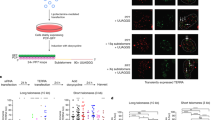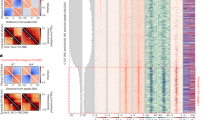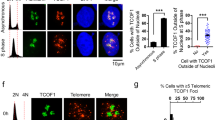Abstract
In yeast (Saccharomyces cerevisiae), transcriptional activators, such as Gal4 and Gal4–VP16, work ordinarily from sites located in the upstream activating sequence (UAS) positioned about 250 base pairs upstream of the transcription start site1. In contrast to their behaviour in mammalian cells, however, such activators fail to work when positioned at distances greater than ∼600–700 base pairs upstream2, or anywhere downstream3,4 of the gene. Here we show that, in yeast, a gene bearing an enhancer positioned 1–2 kilobases downstream of the gene is activated if the reporter is linked to a telomere, but not if it is positioned at an internal chromosomal locus. These observations are explained by the finding that yeast telomeres form back-folding, or looped, structures. Because yeast telomeric regions resemble the heterochromatin found in higher eukaryotes, these findings might also explain why transcription of some higher eukaryotic genes depends on their location in heterochromatin.
This is a preview of subscription content, access via your institution
Access options
Subscribe to this journal
Receive 51 print issues and online access
$199.00 per year
only $3.90 per issue
Buy this article
- Purchase on Springer Link
- Instant access to full article PDF
Prices may be subject to local taxes which are calculated during checkout





Similar content being viewed by others
References
Guarente, L., Yocum, R. R. & Gifford, P. A GAL10-CYC1 hybrid yeast promoter identifies the GAL4 regulatory region as an upstream site. Proc. Natl Acad. Sci. USA 79, 7410–7414 (1982).
Keegan, L., Gill, G. & Ptashne, M. Separation of DNA binding from the transcription-activating function of a eukaryotic regulatory protein. Science 231, 699–704 (1986).
Guarente, L. & Hoar, E. Upstream activation sites of the CYC1 gene of Saccharomyces cerevisiae are active when inverted but not when placed downstream of the “TATA box”. Proc. Natl Acad. Sci. USA 81, 7860–7864 (1984).
Struhl, K. Genetic properties and chromatin structure of the yeast gal regulatory element: an enhancer-like sequence. Proc. Natl Acad. Sci. USA 81, 7865–7869 (1984).
Gottschling, D. E., Aparicio, O. M., Billington, B. L. & Zakian, V. A. Position effect at S. cerevisiae telomeres: reversible repression of Pol II transcription. Cell 63, 751–762 (1990).
Aparicio, O. M. & Gottschling, D. E. Overcoming telomeric silencing: a trans-activator competes to establish gene expression in a cell cycle-dependent way. Genes Dev. 8, 1133–1146 (1994).
Aparicio, O. M., Billington, B. L. & Gottschling, D. E. Modifiers of position effect are shared between telomeric and silent mating-type loci in S. cerevisiae. Cell 66, 1279–1287 (1991).
Strahl-Bolsinger, S., Hecht, A., Luo, K. & Grunstein, M. SIR2 and SIR4 interactions differ in core and extended telomeric heterochromatin in yeast. Genes Dev. 11, 83–93 (1997).
Boeke, J. D., LaCroute, F. & Fink, G. R. A positive selection for mutants lacking orotidine-5′-phosphate decarboxylase activity in yeast: 5-fluoro-orotic acid resistance. Mol. Gen. Genet. 197, 345–346 (1984).
Wu, Y., Reece, R. J. & Ptashne, M. Quantitation of putative activator-target affinities predicts transcriptional activating potentials. EMBO J. 15, 3951–3963 (1996).
Ptashne, M. & Gann, A. Transcriptional activation by recruitment. Nature 386, 569–577 (1997).
Wakimoto, B. T. Beyond the nucleosome: epigenetic aspects of position-effect variegation in Drosophila. Cell 93, 321–324 (1998).
Boivin, A. & Dura, J. M. In vivo chromatin accessibility correlates with gene silencing in Drosophila. Genetics 150, 1539–1549 (1998).
Gottschling, D. E. Telomere-proximal DNA in Saccharomyces cerevisiae is refractory to methyltransferase activity in vivo. Proc. Natl Acad. Sci. USA 89, 4062–4065 (1992).
Braunstein, M., Sobel, R. E., Allis, C. D., Turner, B. M. & Broach, J. R. Efficient transcriptional silencing in Saccharomyces cerevisiae requires a heterochromatin histone acetylation pattern. Mol. Cell Biol. 16, 4349–4356 (1996).
Turner, B. M., Birley, A. J. & Lavender, J. Histone H4 isoforms acetylated at specific lysine residues define individual chromosomes and chromatin domains in Drosophila polytene nuclei. Cell 69, 375–384 (1992).
Dorer, D. R. & Henikoff, S. Expansions of transgene repeats cause heterochromatin formation and gene silencing in Drosophila. Cell 77, 993–1002 (1994).
Devlin, R. H., Bingham, B. & Wakimoto, B. T. The organization and expression of the light gene, a heterochromatic gene of Drosophila melanogaster. Genetics 125, 129–140 (1990).
Dorsett, D. Distant liaisons: long-range enhancer-promoter interactions in Drosophila. Curr. Opin. Genet. Dev. 9, 505–514 (1999).
Durfee, T. et al. The retinoblastoma protein associates with the protein phosphatase type 1 catalytic subunit. Genes Dev. 7, 555–569 (1993).
Sandell, L. L., Gottschling, D. E. & Zakian, V. A. Transcription of a yeast telomere alleviates telomere position effect without affecting chromosome stability. Proc. Natl Acad. Sci. USA 91, 12061–12065 (1994).
Bourns, B. D., Alexander, M. K., Smith, A. M. & Zakian, V. A. Sir proteins, Rif proteins, and Cdc13p bind Saccharomyces telomeres in vivo. Mol. Cell Biol. 18, 5600–5608 (1998).
Alexander, C., Grueneberg, D. A. & Gilman, M. Z. Studying heterologous transcription factors in yeast. Methods Companion Methods Enzymol. 5, 147–155 (1993).
Braunstein, M., Rose, A. B., Holmes, S. G., Allis, C. D. & Broach, J. R. Transcriptional silencing in yeast is associated with reduced nucleosome acetylation. Genes Dev. 7, 592–604 (1993).
Acknowledgements
We wish to thank S. Kantrow for her technical assistance and G. Bryant for his help with the quantitative PCR analysis. We are grateful to J. V. Ravetch, Head, Laboratory of Molecular Genetics & Immunology, The Rockefeller University, for his support of D.d.B. and R.A.L. during this work. We also thank T. De Lange and M. Grunstein for comments on the manuscript. M.P. is a Ludwig Foundation Professor. This work was supported in part by NIH and a fellowship from the Norman and Rosita Winston Foundation (Z.Z.).
Author information
Authors and Affiliations
Corresponding author
Rights and permissions
About this article
Cite this article
de Bruin, D., Zaman, Z., Liberatore, R. et al. Telomere looping permits gene activation by a downstream UAS in yeast. Nature 409, 109–113 (2001). https://doi.org/10.1038/35051119
Received:
Accepted:
Issue Date:
DOI: https://doi.org/10.1038/35051119
This article is cited by
-
In vivo chromatin organization on native yeast telomeric regions is independent of a cis-telomere loopback conformation
Epigenetics & Chromatin (2020)
-
Chromatin architecture and virulence-related gene expression in eukaryotic microbial pathogens
Current Genetics (2019)
-
Transcriptional outcome of telomere signalling
Nature Reviews Genetics (2014)
-
Dot1 binding induces chromatin rearrangements by histone methylation-dependent and -independent mechanisms
Epigenetics & Chromatin (2011)
-
Sex-biased transcription enhancement by a 5' tethered Gal4-MOF histone acetyltransferase fusion protein in Drosophila
BMC Molecular Biology (2010)
Comments
By submitting a comment you agree to abide by our Terms and Community Guidelines. If you find something abusive or that does not comply with our terms or guidelines please flag it as inappropriate.



